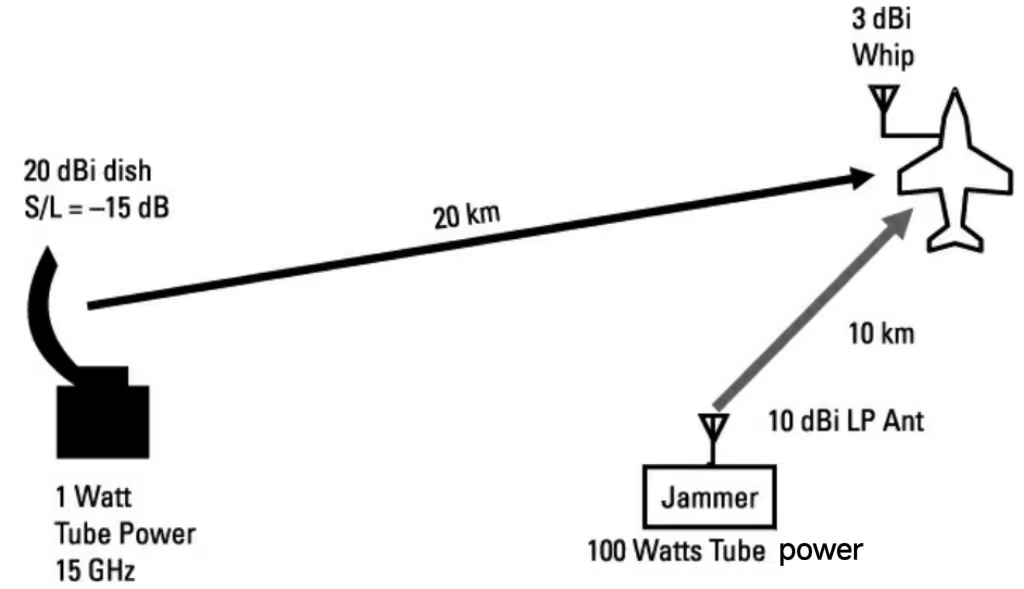
- English
- Español
- Português
- русский
- Français
- 日本語
- Deutsch
- tiếng Việt
- Italiano
- Nederlands
- ภาษาไทย
- Polski
- 한국어
- Svenska
- magyar
- Malay
- বাংলা ভাষার
- Dansk
- Suomi
- हिन्दी
- Pilipino
- Türkçe
- Gaeilge
- العربية
- Indonesia
- Norsk
- تمل
- český
- ελληνικά
- український
- Javanese
- فارسی
- தமிழ்
- తెలుగు
- नेपाली
- Burmese
- български
- ລາວ
- Latine
- Қазақша
- Euskal
- Azərbaycan
- Slovenský jazyk
- Македонски
- Lietuvos
- Eesti Keel
- Română
- Slovenski
- मराठी
- Srpski језик
UAV communication links inInterferes with microwave frequency bands
2023-06-26
Unlike radar, which detects targets, the purpose of a communication system is to transmit information from one location to another. Therefore, interference with communication systems is different from interference with radar systems. A simple communication interference scenario is shown below:

Where, the power S of the useful signal received by the receiver = ERps-LS +Gr, where ERPs is the equivalent radiated power (dBm) of the useful signal transmitter in the direction of the receiver, Ls is the link loss (dB), and Gr is the gain (dB) of the receiving antenna in the direction of the useful signal transmitter.
The jamming object of the jammer is the target receiver, not the transmitter, which is different from the jamming of the radar system, because usually the transmitter of the radar is in the same place as the receiver.
If interference to unmanned aerial vehicle (UAV) links is considered, the jamming object needs to be considered. The drone has a control link from the control station to the drone, also called an uplink; It also has a data link from the drone to the control station, also known as a downlink.
Interference to the control link
The control link is an uplink, so the jamming target of the jammer is the UAV. The jamming scenario is shown in the figure below, and some general parameter assumptions are given: the butterfly antenna gain of the control station is 20dBi, the sidlobe isolation is 15dB, and the transmitter power is 1W. The UAV is 20km away from the ground station, and the UAV's whip antenna gain is 3dBi.

When the jammer is pointed at the drone, the ERPs of the useful signal received by the target receiver:
30dBm+20dB=50dBm;
Uplink loss:
Ls=32.4+20log(20)+20log(5000)=132.4dB;
The interference distance is 10km from the UAV, and the interference link loss is calculated:
Lj=32.4+20log(10)+20log(5000)=126.4dB;
EPRj of jammer: 50dBm+10dB=60dB;
Here, it is assumed that the receiving antenna on the UAV is a whip antenna, and the gain in the ground station direction and the jammer direction is the same, so the dry signal ratio J/S(dB)=ERPj-ERPs-Lj+Ls=16dB can be calculated.
Interference to the data link
The data link is also a downlink, and the jamming target of the jammer changes to the ground station. Since the butterfly antenna is assumed to be adopted by the ground station, the interfering signal usually enters from the side lobe of its antenna, and the jamming scene is as follows:

At this time, the useful signal ERPs=33dBm, the link loss is 132.4dB; The ERPj of the jammer is 60dBm, and the gain of the ground station in the direction of the jammer is 15dB lower than the gain of the main lobe where the UAV is located, so it is 20-15=5dBi, and the dry signal ratio is calculated:
J/S(dB)=ERPj-Lj+Gj-(ERPs-Ls+Gr)=12dB;
